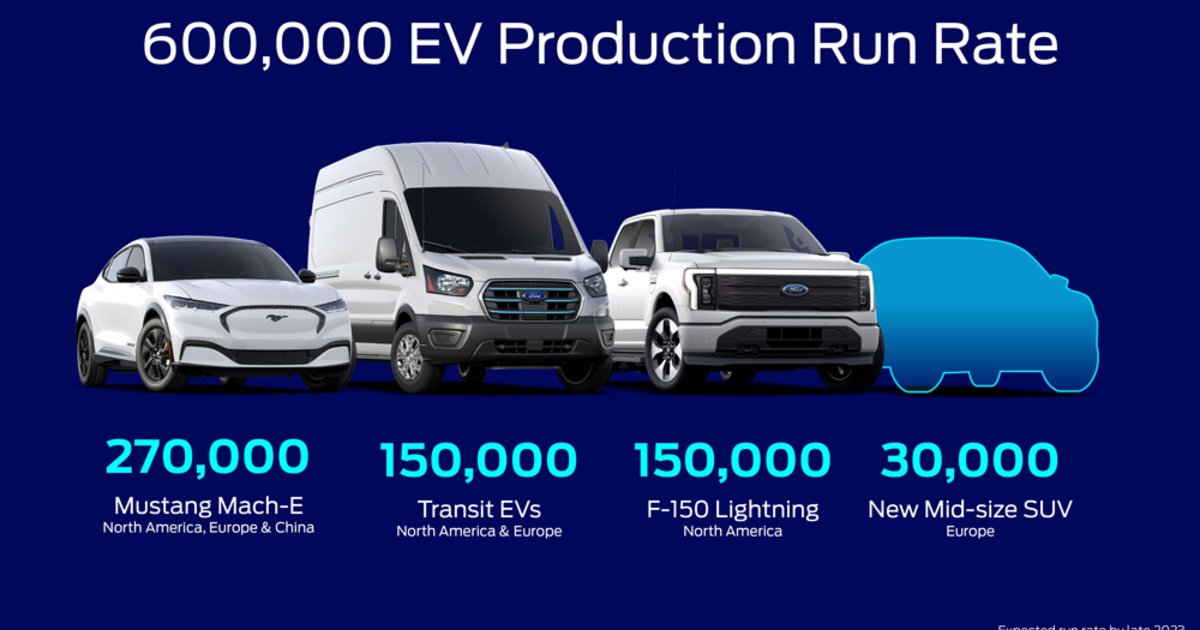
Ford Motor Co. on Thursday said it plans to add a new battery cell chemistry to its electric vehicle portfolio to increase capacity and make them cheaper to build.
The automaker plans to add lithium iron phosphate cells to standard-range versions of the Mustang Mach-E next year and to the F-150 Lightning in early 2024, a move it said will reduce material costs for those vehicles by 10 to 15 percent. The automaker currently uses nickel cobalt manganese battery packs for those vehicles and its E-Transit van.
The chemistry addition is one of a number of battery-related initiatives Ford announced Thursday as it seeks to ramp global EV production to a run rate of 600,000 vehicles next year and 2 million by 2026. Ford said it already has secured all of the battery cell capacity needed for the 2023 target and has 70 percent of what it needs to achieve its 2026 goal.
“Ford’s new electric vehicle lineup has generated huge enthusiasm and demand, and now we are putting the industrial system in place to scale quickly,” CEO Jim Farley said in a statement. “Our Model e team has moved with speed, focus and creativity to secure the battery capacity and raw materials we need to deliver breakthrough EVs for millions of customers.”
The news came a day after a report from Bloomberg said the automaker is planning to cut up to 8,000 jobs in the coming weeks as it works to fund its EV efforts. The cuts would come from the division known as Ford Blue, which is responsible for internal combustion vehicles; the automaker’s EV unit is now known as Model e, with Farley as its president.
On a call with analysts and media, Lisa Drake, Ford Model e vice president, EV Industrialization, declined to directly address the job cuts report, but said the company’s Model e team will be able to quickly ramp EV production due to its nimbleness.
“Smaller is better,” she said. “A smaller team can move faster than a larger team and that was a bit of the underpinning of why we split the company internally. That allows the agility and the speed that we needed.”
Ford said Contemporary Amperex Technology Co. Ltd. will provide the lithium iron phosphate battery packs for the Mach-E and Lightning. The automaker also will continue working with LG Energy Solution and SK Innovation.
Ford said it plans to localize and use 40 gigawatt-hours of lithium iron phosphate cell capacity in North America starting in 2026. It also signed a nonbinding memorandum of understanding with CATL to “explore cooperation” for supplying batteries across North America and overseas markets.
Ford said it has sourced “most of the nickel” needed through 2026 through a number of agreements with mining companies and has also secured several contracts for lithium.
“Our team has been actively engaged with partners in the United States and around the world,” Drake said in a statement. “We will move fast in the key markets and regions where critical supplies are available, meeting with government officials, mining companies and processors and signing MOUs and agreements that reflect Ford’s ESG expectations and underpin Ford’s plan to bring EVs to millions.”
Ford for the first time Thursday broke down how it plans to reach 600,000 EVs by next year: 270,000 Mustang Mach-Es for North America, Europe and China; 150,000 F-150 Lightnings for North America; 150,000 Transit EVs for North America and Europe; and 30,000 units of a new SUV for Europe.
Ford last year announced it would boost Mach-E production at its plant in Cuautitlan, Mexico by moving another planned EV program out of the plant and reserving that space for more Mach-Es. Drake said Thursday that when it adds the LFP cells, the plant will go from building about 2,000 Mach-Es per week to 4,000 per week.
Ford executives have said recently the Mach-E is no longer profitable due to rising costs. Drake said the addition of the LFP chemistry will help it return to profitability.
“We know the battery material cost is where the war will be won in the short-term,” she said. “By far LFP chemistry will give us the biggest step function down in that material cost.”
She also said that Ford could add the LFP chemistry to its E-Transit van in the future. The electric van is currently built alongside the gas version at Ford’s Kansas City Assembly Plant.
The automaker previously said it plans to invest more than $50 billion in EVs through 2026. It is targeting total company adjusted earnings before interest and taxes margins of 10 percent, with 8 percent margins for EVs.